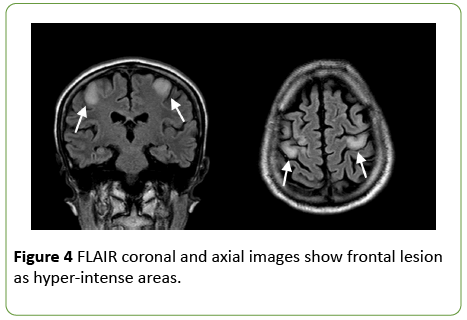Clinical manifestations are diverse. It was first described by two Italian pathologists who identified it in the autopsies of three patients who presented in status epilepticus and subsequently developed coma 1.
 Marchiafava Bignami Disease Uncertain Mri Predictors Of Outcome Insight Medical Publishing
Marchiafava Bignami Disease Uncertain Mri Predictors Of Outcome Insight Medical Publishing
Marchiafava Bignami disease is defined by characteristic demyelination of the corpus callosum erosion of the protective covering of nerve fibers joining the 2 hemispheres of the brain.

Marchiafava bignami disease. Chronic diseasesuncommon chronic brain disorder called Marchiafava-Bignami disease which involves the degeneration of the corpus callosum the tissue that connects the two hemispheres of the brain. Emuaid Defeats Severe Nerve Pain. Marchiafava-Bignami disease MB refers to a disorder resulting in demyelination of the corpus callosum.
Emuaid Defeats Severe Nerve Pain. Pathology and circumstances link this disorder to osmotic demyelination syndrome previously called central pontine myelinolysis of which it. Other articles where Marchiafava-Bignami disease is discussed.
Ad Emuaid Gave Me My Life Back I Am So Thankful For This Amazing Product. I Found One Fast Simple Trick. Hathaway BM Chien L.
27 reviewed data from 153 cases of Marchiafava-Bignami disease MBD confirmed by brain imaging. Ad Emuaid Gave Me My Life Back I Am So Thankful For This Amazing Product. MarchiafavaBignami disease MBD or syndrome is a rare progressive neurological disease characterized by selective demyelination of the corpus callosum and cortical laminar necrosis involving the frontal or temporal lobes and subsequently resulting in atrophy.
5573080 PubMed - indexed for MEDLINE MeSH Terms. Marchiafava-Bignami disease is a rare demyelination of the corpus callosum that occurs in patients with chronic alcohol use disorder predominantly men. In 2017 Hillborn et al.
Marchiafava-Bignami disease MBD is a rare condition characterized by demyelination of the corpus callosum. The disease seems to most often affect severe and chronic alcoholics in their middle or late adult life. Marchiafava-Bignami disease MBD is a rare outcome often associated with chronic alcohol abuse.
Marchiafava-Bignami disease MBD is a rare condition mainly associated with alcoholism although it may be mimicked by several other disorders that cause corpus callosum lesions. Recently brain magnetic resonance imaging has paved the way for the diagnosis of MBD. It was discovered in 1903 by.
Marchiafava-Bignami disease Marchiafava-Bignami disease MBD is a very rare disorder of demyelinationnecrosis of the corpus callosum and the near subcortical white matter that is especially predominant in ill-fed alcoholics. Marchiafava Bignami disease is defined by characteristic demyelination of the corpus callosum erosion of the protective covering of nerve fibers joining the 2 hemispheres of the brain. The disease seems to most often affect severe and chronic alcoholics in their middle or late adult life.
I Found One Fast Simple Trick. What is Marchiafava Bignami disease. It was discovered in 1903 by Italian pathologists Ettore Marchiafava and Amico Bignami.
It is seen most often in patients with chronic alcoholism. Marchiafava-Bignami disease MBD is a rare alcohol associated disorder characterized by demyelination and necrosis of the corpus callosum1 It is a radiological diagnosis as clinical features are variable and non-specific2 We report two cases of Marchiafava-Bignami disease who had history of chronic alcoholism different clinical. Other brain damage occasionally reported in alcoholics includes cortical laminar sclerosis cerebellar.
Our objective was to identify helpful features for differential diagnosis and assess whether any treatment can be recommended. A 62-year-old man was admitted to our hospital because of headache and mild cognitive impairment. Marchiafava-Bignami disease MBD is a very rare disorder of demyelinationnecrosis of the corpus callosum and the near subcortical white matter that is especially predominant in ill-fed alcoholics.
They observed a significant trend for a better overall outcome in.
























